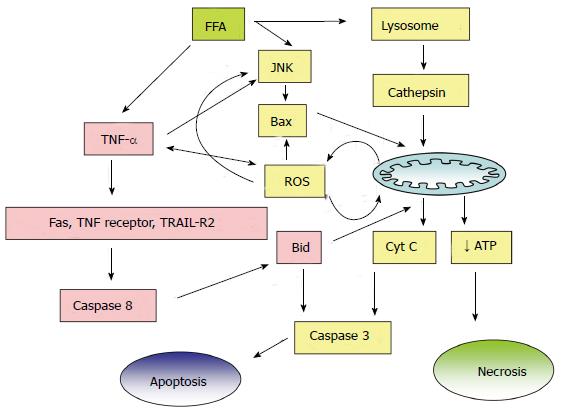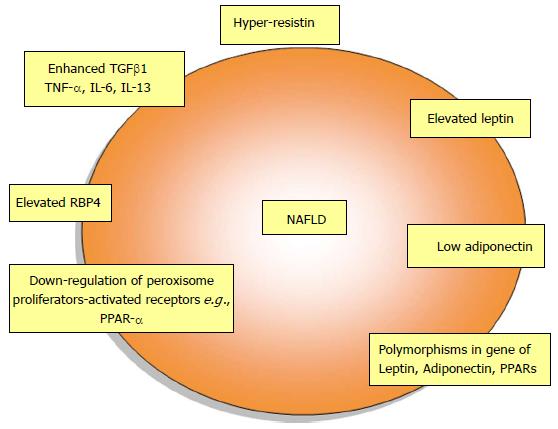Copyright
©2014 Baishideng Publishing Group Inc.
World J Hepatol. Aug 27, 2014; 6(8): 570-579
Published online Aug 27, 2014. doi: 10.4254/wjh.v6.i8.570
Published online Aug 27, 2014. doi: 10.4254/wjh.v6.i8.570
Figure 1 Mechanism of action of adenosine monophosphate-dependent protein kinase.
AMP: Adenosine monophosphate; AMPK: AMP-dependent protein kinase.
Figure 2 Role of adipokines in inflammation and fibrosis.
NAFLD: Nonalcoholic fatty liver disease; NASH: Nonalcoholic steatohepatitis. TNF-α: Tumor necrosis factor alpha; HSCs: Hepatic stellate cells.
Figure 3 Activation of peroxisome proliferator-activated receptors α and associated biological response in adipose tissue.
TNF-α: Tumor necrosis factor α; COX-2: Cyclooxygenase-2; IL-1: Interleukin-1; FFA: Free fatty acids; RXR: Retinoid receptor; SMRT: Silencing mediator of retinoid and thyroid hormone receptors; NCoR1: Nuclear receptor co-repressor 1; PPAR: Peroxisome proliferator-activated receptors.
Figure 4 Cytotoxic effects of free fatty acids in nonalcoholic fatty liver disease.
FFA: Free fatty acid; JNK: c-Jun NH(2)-terminal kinase; ROS: Reactive oxygen species; TRAIL-R2: Tumor necrosis factor-related apoptosis inducing ligand; ATP: Adenosine triphosphate.
Figure 5 Changes of adipokines and peroxisome proliferator-activated receptors in nonalcoholic fatty liver disease.
TGFβ1: Transforming growth factor beta 1; TNF-α: Tumor necrosis factor alpha; RBP4: Retinol binding protein 4. NAFLD: Nonalcoholic fatty liver disease; PPAR: Peroxisome proliferator-activated receptors.
- Citation: Giby VG, Ajith TA. Role of adipokines and peroxisome proliferator-activated receptors in nonalcoholic fatty liver disease. World J Hepatol 2014; 6(8): 570-579
- URL: https://www.wjgnet.com/1948-5182/full/v6/i8/570.htm
- DOI: https://dx.doi.org/10.4254/wjh.v6.i8.570













